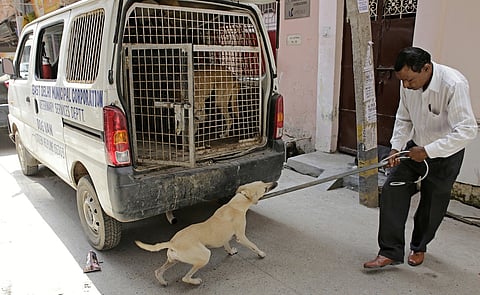

This is the fifth in a 6-part series. Read the first, second, third, fourth and sixth parts
On August 11, a 2-judge bench of Justice J B Pardiwala and Justice R Mahadevan directed that stray dogs be removed from the streets of Delhi and the National Capital Region as early as possible.
The bench had taken suo motu cognisance of a news report in the Times of India’s Delhi edition on July 28. It noted that the news item contained “very disturbing and alarming” figures and facts.
The Chief Justice of India B R Gavai later shifted the case from a two-judge Supreme Court bench to a three-judge one. The new bench, headed by Justice Vikram Nath and comprising Justices Sandeep Mehta and N V Anjaria, reserved its order on an interim plea seeking a stay on the earlier directive on August 14.
On August 22, 2025, this bench stayed the earlier order directing the removal of free-ranging dogs from the Delhi-National Capital Region to shelters, while ruling that feeding them in public spaces is illegal.
Down To Earth (DTE) wanted to probe the issue further. In nature, dogs and vultures often compete for carcasses. We wanted to understand the reason behind why dogs have become a menace for humans and non-human animals alike. Could the decline of the vulture in the 1990s have contributed to the dog’s rise?
DTE spoke to a number of experts on the matter. Here, we talk to NVK Ashraf, a senior advisor and chief veterinarian from Wildlife Trust of India (WTI), based in Thrissur, Kerala.
According to Ashraf, poor food waste management by humans allowing easy access for dogs in rural and urban areas has also contributed to a rapid increase in dog populations.
“This is compounded by dog lovers who feed stray canines without sterilising them,” he said.
Ashraf said a female free-ranging dog can give birth to a litter size of about five to six pups at once. Natural survival is low, but extra care by humans is ensuring more survival.
Anindita Bhadra, biologist and associate professor at Dog Lab, Indian Institute of Science, Education and Research, Kolkata, has explained in an earlier conversation with DTE that her research showed only 19 per cent of such pups survived.
But positive human interactions such as humans adopting newborns and giving them food, shelter and blankets had helped increase dog populations.
Ashraf said a contrasting situation emerges in Kerala where people do not feed the dogs in public spaces apart from a few exceptional cases which may also be unwillingly.
Ashraf said dogs are unlikely to be visible during daytime hours in Kerala. But as evening progresses, dogs start prowling the streets in search of discarded food from restaurants and food kiosks.
However, such non-integration of humans with dogs has made dogs feral, made them search for food in wildlife-dominant areas and become more aggressive in behaviour.
“Such negative interaction between dogs and humans make them roam in packs in less human- dominated areas and as a result, leads to instances of attack on humans and mauling children,” he added.
Ashraf said such extreme behaviour of humans may not be favourable towards dogs.
Down To Earth examines whether the decline of the vulture could have led to the rise of the dog as India’s preeminent scavenger/predator.